I am having some trouble getting my code to work. I earlier asked a question on this website that did not solve my problem entirely. "Reshaping the HRS data from wide to long and creating a time variable"
This time I tried to be very clear and precise in describing my data. It looks like something like this, where all the variables start with "r" followed by a number from 1 to 10 followed by the variable measured. The only variable that does not start with "r" is the id-tracker which is called "idhhpn".
This is a sample of how my data is structured, but not exactly my data. My data file is very large and I can't post it here:
df <- structure(list(data = structure(1:4, .Label = c("Ind_1", "Ind_2",
"Ind_3", "Ind_4"), class = "factor"), r1weight = c(56, 76, 87, 64
),r10weight = c(57, 75, 88, 66), r1height = c(186, 176, 187, 165), r10height = c(187L,
173L, 185L, NA), r1bmi = c(23L, 22L, 25L, 21L), r10bmi = c(24L, 23L,
29L, 23), r1logass = c(8L, 4L, NA, 2L), r10logass = c(7, 5L, 2,
4L), r1vigact = c(1, 0, 1, 1), r10vigact = c(0,0,0,1), idhhpn = c(1,2,3,4), rmale = c(0,0,1,0), rhighs = c(1,1,1,0), rcoll = c(1,0,1,0) ), class =
"data.frame", row.names = c(NA,
-4L))
data r1weight r10weight r1height r10height r1bmi r10bmi r1logass r10logass r1vigact r10vigact idhhpn rmale rhighs rcoll
1 Ind_1 56 57 186 187 23 24 8 7 1 0 1 0 1 1
2 Ind_2 76 75 176 173 22 23 4 5 0 0 2 0 1 0
3 Ind_3 87 88 187 185 25 29 NA 2 1 0 3 1 1 1
4 Ind_4 64 66 165 NA 21 23 2 4 1 1 4 0 0 0
`
I have 23 variables all observed 10 times (one every year for 10 years). I also have Several dummies like rmale, rhispanic, rblack, rHS, rGED, rCollege and so on.
I wish to convert this into this:
dflong <- structure(list(time = structure(1:12, .Label = c("1", "...","10","1", "...","10","1", "...","10", "1", "...","10"),
class = "factor"), idhhpn = c(1,1,1,2,2,2,3,3,3,4,4,4), W = c(56,"...", 57,76,"...",75,87,"...",88,64,"...",66),
H = c(186,"...",187,176,"...",173,187,"...",185,165,"...","..."), BMI = c(23,"...",24,22,"...",23,25,"...",29,21,"...",23),
logA = c(8,"...",7,4,"...",5,"...","...",2,2,"...",4), vigact = c(1,"...",0,0,"...",0,1,"...",0,1,"...",1),
rmale = c(0,"...",0,0,"...",0,1,"...",1,0,"...",0), rhighs = c(1,"...",1, 1,"...",1,1, "...",1,0,"...",0),
rcoll = c(1,"...",1,0,"...",0,1,"...",1,0,"...",0)),
class = "data.frame", row.names = c(NA, -12L))`
time idhhpn W H BMI logA vigact rmale rhighs rcoll
1 1 1 56 186 23 8 1 0 1 1
2 ... 1 ... ... ... ... ... ... ... ...
3 10 1 57 187 24 7 0 0 1 1
4 1 2 76 176 22 4 0 0 1 0
5 ... 2 ... ... ... ... ... ... ... ...
6 10 2 75 173 23 5 0 0 1 0
7 1 3 87 187 25 ... 1 1 1 1
8 ... 3 ... ... ... ... ... ... ... ...
9 10 3 88 185 29 2 0 1 1 1
10 1 4 64 165 21 2 1 0 0 0
11 ... 4 ... ... ... ... ... ... ... ...
12 10 4 66 ... 23 4 1 0 0 0
Where there is also a time variable going from 1 to 10 for each individual for each variable as shown.
Where I have omitted timestamps 2-9 (for readability)
I currently have the following code which I am certain is almost correct.
HRSdata_melt <- HRSdata %>% gather(time,ind,-HRSdata) %>%
mutate(time=gsub("r([1-10])", "\\1_",time)) %>%
separate(time, into = c("time", "idhhpn")) %>%
spread(idhhpn, ind)
but it gives me the following error which I think is due to some minor error.


